Easy Gochujang Eggplant
Jump to RecipeThis yummy gochujang eggplant has bold flavours and a deliciously spicy taste. This 30-minute recipe is a healthy weeknight offering that’s vegan and gluten-free. It’s made with crispy baked eggplant slices glazed with a fiery gochujang sauce. It’s the perfect recipe with steamed rice!

Table of Contents
Why you’ll love this recipe
Spicy – This Korean fried eggplant recipe is made with gochujang, which gives the dish its fiery flavour.
Healthy – Made with primarily aubergine and seasonings, this gochujang eggplant dish is full of nutrients.
Delicious – With ingredients like gochujang, soy sauce, coriander, and garlic, each bite is full of spicy umami flavour.
Quick – This Korean eggplant dish only takes about 30 minutes, so it’s great for busy weeknights.
Great for meal prep – This Korean eggplant recipe is great for meal prep during the week because you don’t need to reheat the leftovers.
If you have leftover gochujang paste, consider making one of these yummy recipes; Creamy Gochujang Pasta, Gochujang Noodles (Spicy Korean Noodles) or Korean Spiced Turkey Mince, Rice and Baked Kale
What is Gochujang?
Gochujang is a spicy Korean condiment that’s typically made with red chilli paste, salt, fermented soybeans, glutinous rice, and a sweetener. It has a thick consistency and provides a spicy, umami-rich flavour to recipes. Most versions of gochujang are gluten-free/vegan, but it’s best to check the ingredient label before purchasing.
What can you put it on?
It’s quite a versatile ingredient, as it can be used with uncooked and cooked recipes, like this gochujang eggplant. It’s also great as a sauce for noodles, soups, salad dressings, marinades, and, of course, traditional Korean recipes.
What can I use instead of Gochujang sauce? Is it the same as hot pepper paste?
There’s no exact swap for gochujang sauce because of its umami flavours. It’s different from hot pepper paste, which typically just offers a spicy taste and thinner consistency. The closest swap for this sauce is a combination of three ingredients: miso paste, sugar, and Sriracha.
Ingredients
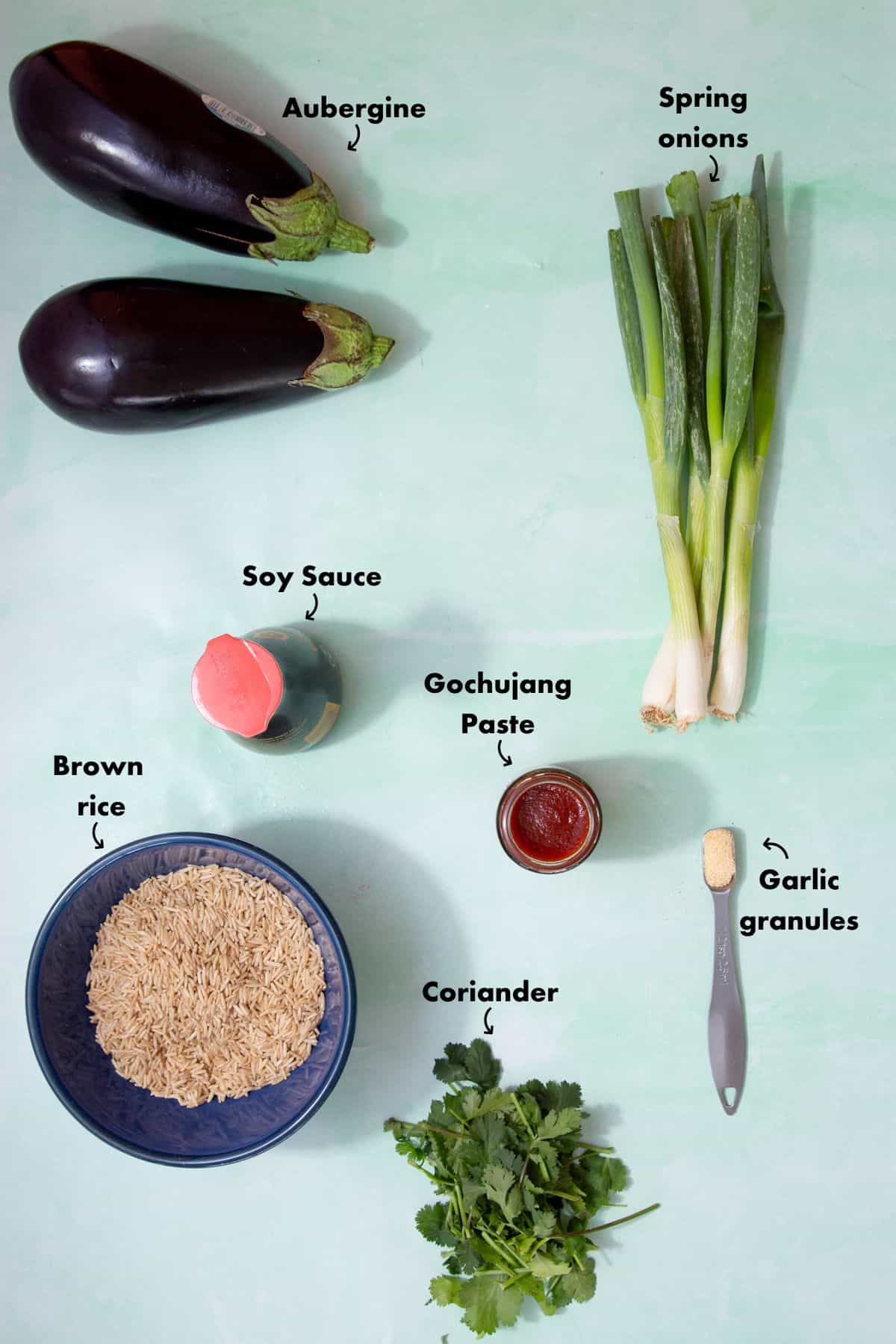
Aubergine – The aubergine in this gochujang eggplant recipe is the star of the show. If you aren’t a fan of eggplant, you can also use other veggies like potatoes, zucchini, portobello mushrooms, and even tofu.
Brown Rice – I recommend using brown rice for this recipe, which helps soak up the fiery glaze. However, Korean eggplant recipes like this one also taste great compared to other types of rice (like jasmine/basmati) or noodles.
Gochujang Sauce – This ingredient helps provide a delightfully spicy, umami-rich taste to the recipe. I don’t recommend skipping gochujang, as it’s the main reason for the complex flavour in this dish. However, you can use a smaller amount if your heat tolerance is low.
See the recipe card for full information on ingredients and quantities.
Variations/ Adaptations
Here are a few ways to alter this yummy gochujang eggplant and make it your own! Instead of serving this Gochujang glazed eggplant over rice, you can serve it over pasta, lo mein, or zucchini noodles (aka courgette noodles). If you don’t want to use eggplant, try this recipe with other veggies like zucchini or potatoes. You can also make this dish with protein instead, like tofu, paneer, chicken, or shrimp.
Instead of creating the spicy glaze with olive oil, consider using toasted sesame oil for a nuttier taste. You can also make the glaze a bit tangier by including rice vinegar.
Light soy sauce will also work for this recipe if you don’t have regular soy sauce, as it has a similar flavour. If you’re really in a pinch, you can use sweet chilli sauce as a glaze instead of the recipe below. It won’t have the umami taste but provides a sweet, spicy flavour.
If you love aubergines, you’ll need to try my ; Grilled Aubergine Curry, Crispy Soy Tofu, Aubergine & Rice and Miso Aubergines with Edamame Beans and Brown rice
How to make Gochujang eggplant
Preheat oven to 356°F (180°C)
- Slice the aubergines lengthways into planks approximately 1 cm wide (Image 1).
- Place the aubergines in a large baking tray and score them with your knife (Image 2).

3. Add the gochujang, soy sauce, garlic granules and oil in a mixing bowl and whisk to combine (Image 3).
4. Pour around ¾ of the glaze onto the aubergines and use a spoon or your hands to ensure both sides are evenly coated. Pop them in the oven, timer set to 30 minutes (Image 4).

*Meanwhile, measure out the rice and add 1:2 ratio of rice to water. Set a timer for your rice according to the packet, mine was 25 minutes.
5. Using the remaining glaze that is left in the bowl, coat the aubergine again when there’s 10 minutes left on your timer (Image 5).
6. Once the timers are all up, you can assemble your meal by adding a layer of rice, some saucy baked aubergine, followed by some sliced spring onions and fresh coriander. Season with salt and some red pepper flakes for some added heat (Image 6).

Satisfy any cravings for vegetarian tasty meals and try my ; Quorn Chicken Pieces Recipe with Pesto, Ultimate Vegan Roast Dinner and The Best Halloumi Burger
Tips for the best result
Using little to no oil on the aubergine creates a nice, crisp vegetable instead of a soggy one.
I recommend this tip for the best results when making Gochujang eggplant, as the vegetable will soften once it’s mixed with the sauce.
Make sure the aubergine is evenly and thinly sliced lengthwise
This will ensure that the aubergine pieces cook evenly for this gochujang aubergine recipe. If you slice eggplant evenly, it will help prevent some pieces from being undercooked or soggy while others are crispy/burnt.
Leave enough space between eggplant pieces
The key to creating crispy aubergine pieces is leaving enough space between them on the baking sheet. This space lets the hot air in the oven/air fryer circulate around the eggplant pieces, leaving you with crispy veg instead of soggy chunks.
Serving Suggestions
I highly recommend serving this gochujang eggplant over brown rice. However, if you prefer noodles, feel free to use those as a base instead. You can use anything from rice noodles to lo mein. I also like adding sesame seeds to this dish for a bit of crunch. If you want a lighter meal, serve this recipe alongside an Asian-inspired salad or soup. Or, try it with stir-fry veggies.
Otherwise, you can add other Korean-inspired dishes on the side, like bulgogi beef or Korean fried chicken.
Try some delicious side dishes to go with the Gochujang eggplant ; Easy Mexican Street Corn Off the Cob, Simple Tricolore Salad and Roasted Mediterranean Vegetables
Leftover Storage and Reheat Instructions
This eggplant Korean recipe stores well in the fridge. If you have any leftover gochujang eggplant, let it fully cool. Then, store it in an airtight container. It should stay good in the fridge for up to five days.
You don’t need to reheat the leftovers of this eggplant gochujang recipe, as they taste good cold as well. However, if you want to reheat the eggplant, you can heat it in the oven or air fryer at 356°F (180°C) for about 10 minutes. Reheat the rice separately in the microwave.
FAQs
No, this versatile condiment doesn’t need to be cooked! You can use it as a dipping sauce, marinade, salad dressing, etc.
Yes, eggplant and aubergine are the same veggies! This purple vegetable is typically called eggplant in the US, Australia, and a few other places. Aubergine is typically used throughout Europe, especially in France, Germany, and Britain.
Yes, you can make the eggplant for this gochujang eggplant recipe in the air fryer. You’ll set the air fryer to the same temp as the oven (356°F/180°C) and air fry it for about 13 minutes. Be sure to toss the eggplant in the air fryer basket a few times as it cooks.
Yes, you can make this Korean eggplant gochujang dish ahead of time. It lasts in the fridge for up to five days. The best part is that it tastes good cold, so you don’t even need to reheat it later.
If you tried this Gochujang Eggplant recipe, it would be mean so much to me if you could leave a review & a star rating to let me know how you found it! I love hearing about your experiences – it motivates me to keep creating more and more recipes for you guys 💛 Let’s get cooking! – Mimi x
Gochujang Eggplant

Ingredients
- 2 aubergines, sliced into 1 cm planks (£1.90)
- 250 g brown rice, washed (£2.50/5)=(£0.50)
- Bunch of spring onions, thinly sliced (£0.59)
- Bunch of fresh coriander, roughly torn (£0.60)
- 3 tbsp Gochujang paste (£1.55)
Cupboard Essentials
- 3 tbsp of soy sauce
- ½ tsp garlic granules
- 2 tbsp of olive oil
Method
Preheat oven to 356°F (180°C)
- Add the Gochujang, soy sauce, garlic granules and oil in a mixing bowl and whisk to combine.
- Slice the aubergines lengthways into planks approximately 1 cm wide.
- Place the aubergines in a large baking tray and score them with your knife. Pour around ¾ of the glaze onto the aubergines and use a spoon or your hands to ensure both sides are evenly coated.
- Pop them in the oven, timer set to 30 minutes. Meanwhile, measure out the rice and add 1:2 ratio of rice to water. Set a timer for your rice according to the packet, mine was 25 minutes.
- Using the remaining glaze that is left in the bowl, coat the aubergine again when there’s 10 minutes left on your timer.
- Once the timers are all up, you can assemble your meal by adding a layer of rice, some saucy baked aubergine, followed by some sliced spring onions and fresh coriander. Season with salt and some red pepper flakes for some added heat.
Notes
- Use little to no oil to achieve a crisp texture, preventing sogginess when making gochujang eggplant.
- Slice the aubergine evenly and thinly lengthwise to ensure even cooking and avoid inconsistent textures.
- Leave enough space between eggplant pieces on the baking sheet for the air to circulate and to allow for crispiness.
Nutrition
Leave a comment and a rating!

- Weekly meal plans with a £20 budget
- 150+ exclusive recipes
- Personal dashboard
- Exclusive step by step videos
- Shopping list tools
- Advert Free experience

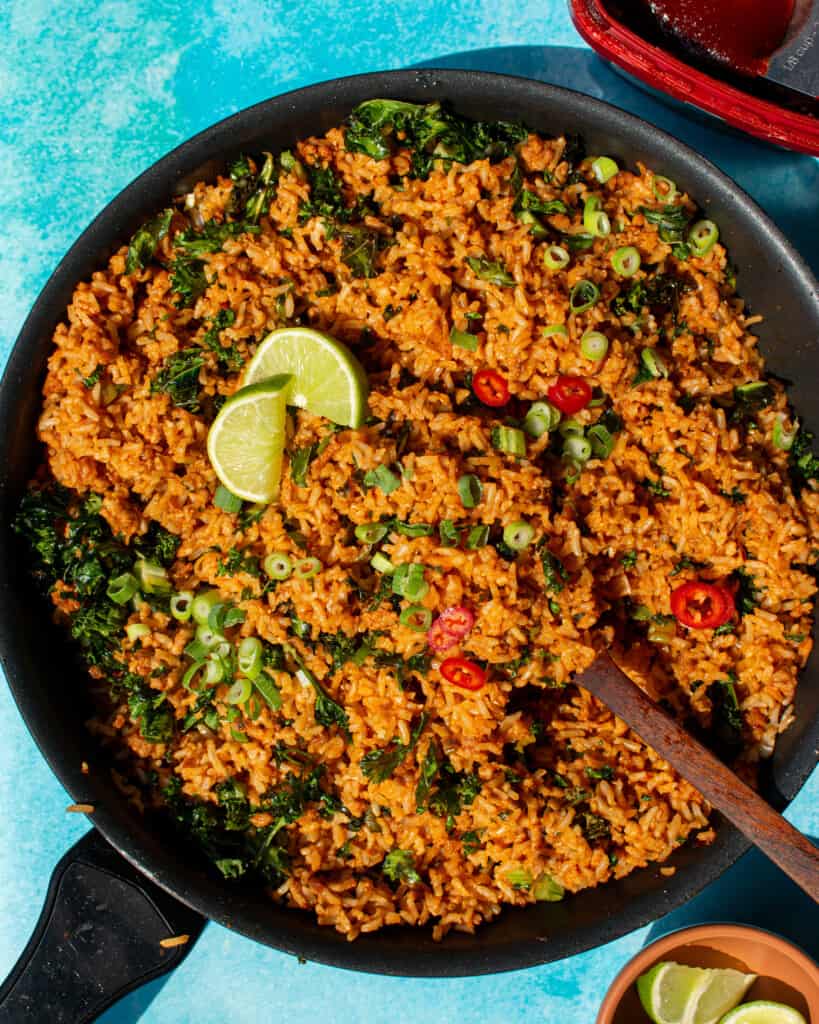

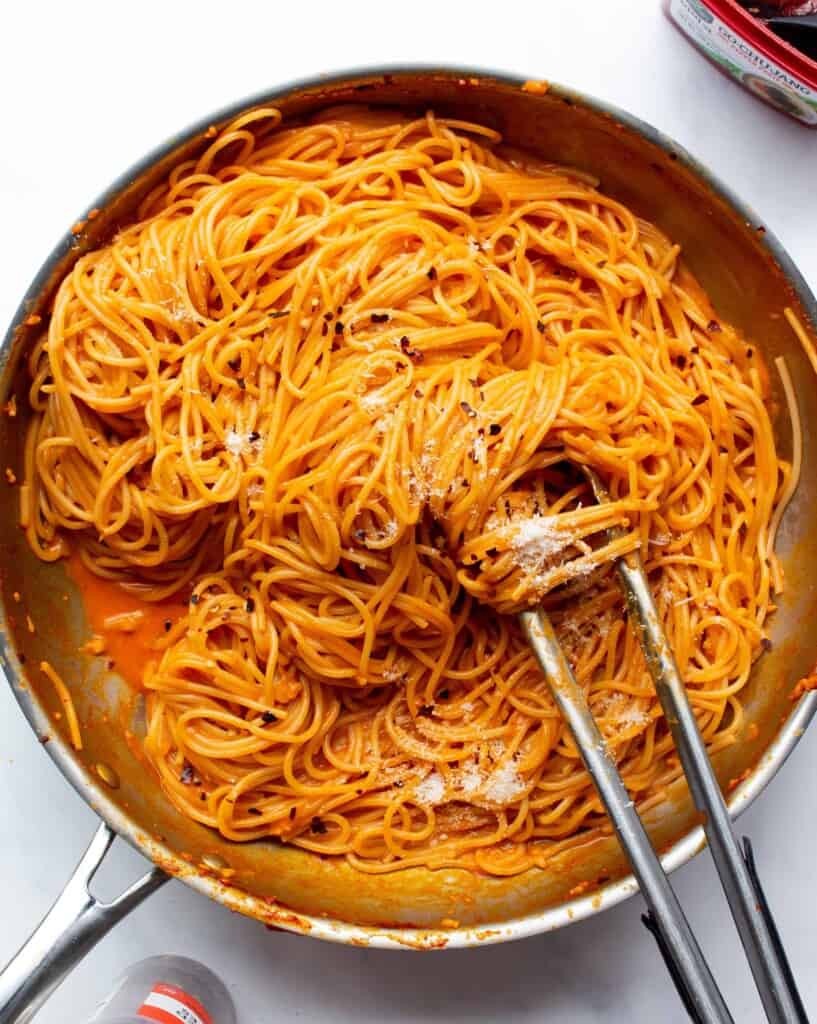



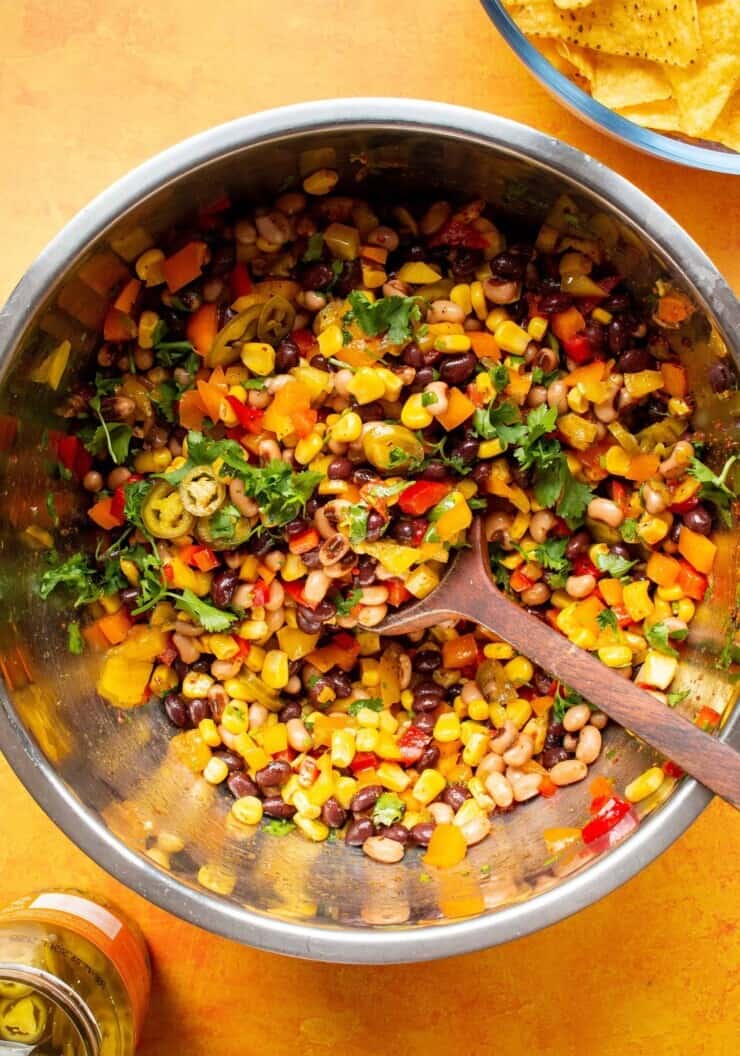
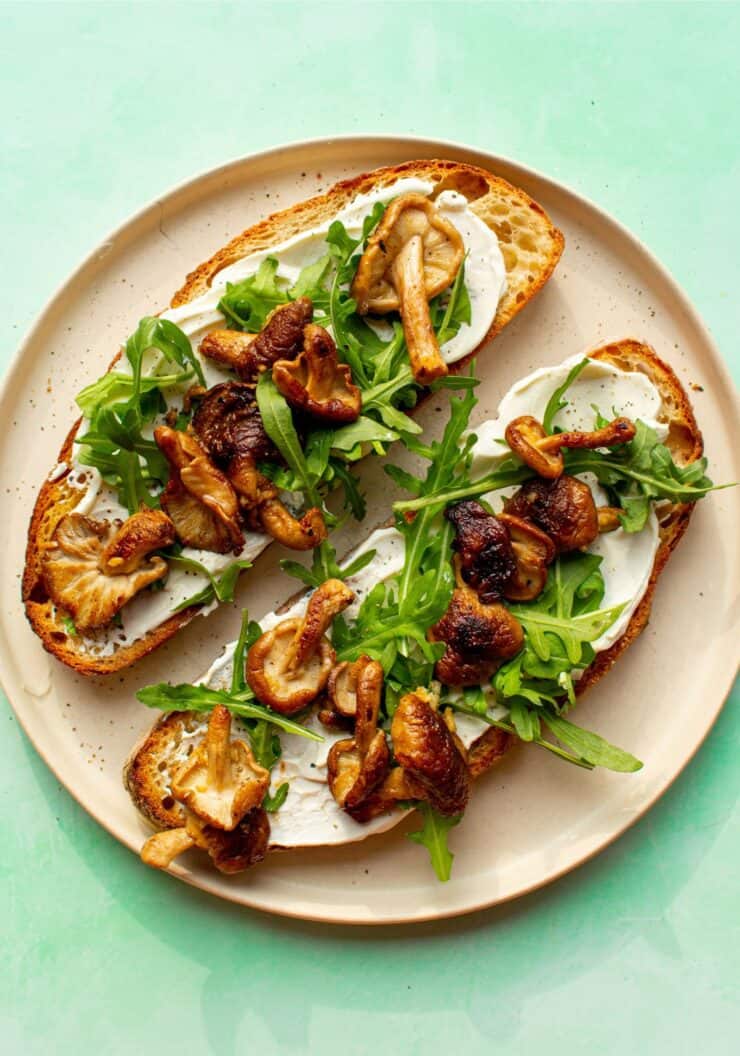
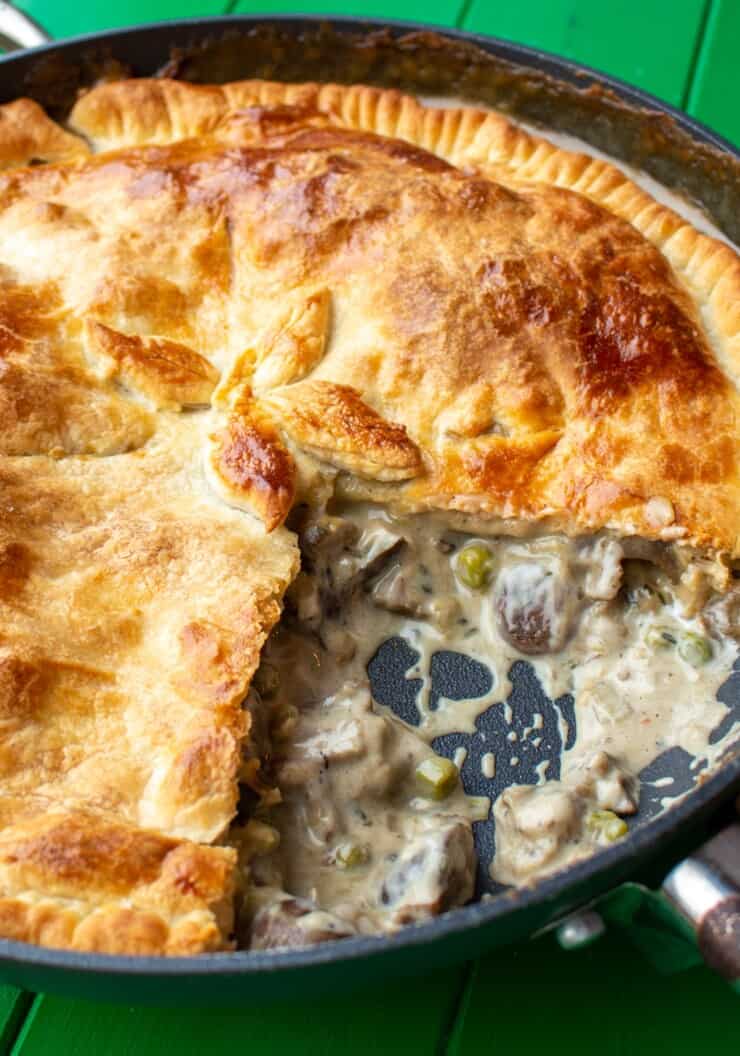
Comments